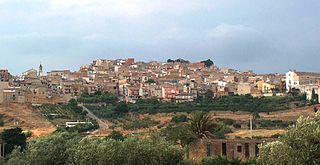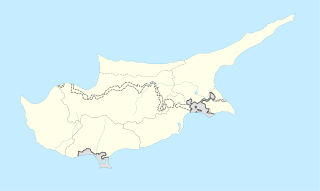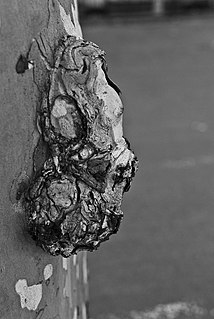
Platanus is a genus consisting of a small number of tree species native to the Northern Hemisphere. They are the sole living members of the family Platanaceae.

The clipper barb or Congo barb is a freshwater and brackish tropical fish belonging to the minnow family (Cyprinidae). Its native habitat is from Côte d'Ivoire through the Chad Basin to Nigeria and Cameroon. It was originally described as Barbus callipterus by Boulenger in 1907.

Acquaviva Platani is a hill town and comune in the province of Caltanissetta.

Casteltermini is a comune (municipality) in the Province of Agrigento in the Italian region Sicily, located about 70 kilometres (43 mi) southeast of Palermo and about 25 kilometres (16 mi) north of Agrigento.

Cianciana is a comune (municipality) in the Province of Agrigento in the Italian region Sicily, located in the middle valley of the Platani river, about 70 kilometres (43 mi) south of Palermo and about 25 kilometres (16 mi) northwest of Agrigento. The Monte Cammarata, elevation 1,579 metres (5,180 ft) above sea level, part of the Monti Sicani chain, is nearby.

San Biagio Platani is a comune (municipality) in the Province of Agrigento in the Italian region Sicily, located about 70 kilometres (43 mi) south of Palermo and about 20 kilometres (12 mi) north of Agrigento. As of 31 December 2004, it had a population of 3,689 and an area of 42.4 square kilometres (16.4 sq mi). San Biagio Platani is famous for its "Easter Arches"
Plataneiko is a river in the northern part of the Achaia prefecture. The river flows entirely in municipalities of Rio and empties into the Gulf of Patras.
Phyllosticta platani is a plant pathogen infecting plane trees. It is found in Eastern North America and Europe.
Splanchnonema platani is a fungus in the genus Splanchnonema. It was formerly known under the name Massaria platani. The anamorph of the fungus is known as Macrodiplodiopsis desmazieresii. The fungus has caused serious damage to plane trees across Europe.

Lamprologus callipterus is a species of cichlid endemic to Lake Tanganyika where it very actively moves about in search of crustaceans and other invertebrates. Males of this species can reach a length of 12.4 centimetres (4.9 in) TL while the females only grow to 4.5 centimetres (1.8 in) TL. This fish can also be found in the aquarium trade, though it is considered to be poorly suited for captivity.

The Platani, known in ancient Greek as the Λύκος or Ἁλυκός, is a river in southern Sicily, Italy. It is the fifth longest in the island after Imera Meridionale, Simeto, Belice and Dittaino, with a course of 103 km, and the third for drainage basin with 1,785 km², after the Simeto and Imera Meridionale. It flows through the provinces of Palermo and Agrigento, marking the boundary between the latter and that of Caltanissetta.

Phyllonorycter platani is a moth of the family Gracillariidae. It is found in Europe, the Near East and the eastern Palearctic ecozone, as well as California in the United States.

Platani is a village in the municipal unit of Rio, Achaea, Greece. In 2011, it had a population of 481. It is situated in the northern foothills of the Panachaiko mountain. It is 4 km east of Rio, and 2 km south of Agios Vasileios.

Platani is a Turkish Cypriot village in the Famagusta District of Cyprus, located 9 kilometres (5.6 mi) north of Lefkoniko. Platani is under the de facto control of Northern Cyprus. It is locally known for the nearby stalactite cave "Incirli Mağra". As of 2011, Platani had a population of 183.

Acalyptris platani is a moth of the family Nepticulidae. It is widespread in southern Europe and western Asia, from Portugal to Iran. It has spread westwards from its original occurrence in the Balkans before 1930, and has since been found in western France and Switzerland. It has also been recorded from Menorca, Bulgaria, Cyprus and Turkey.

Ceratocystis platani is a fungus that causes a disease on plane trees in the genus Platanus.
Stigmina is a genus of fungal plant pathogens.

Willowsia platani is a species of slender springtail in the family Entomobryidae.












